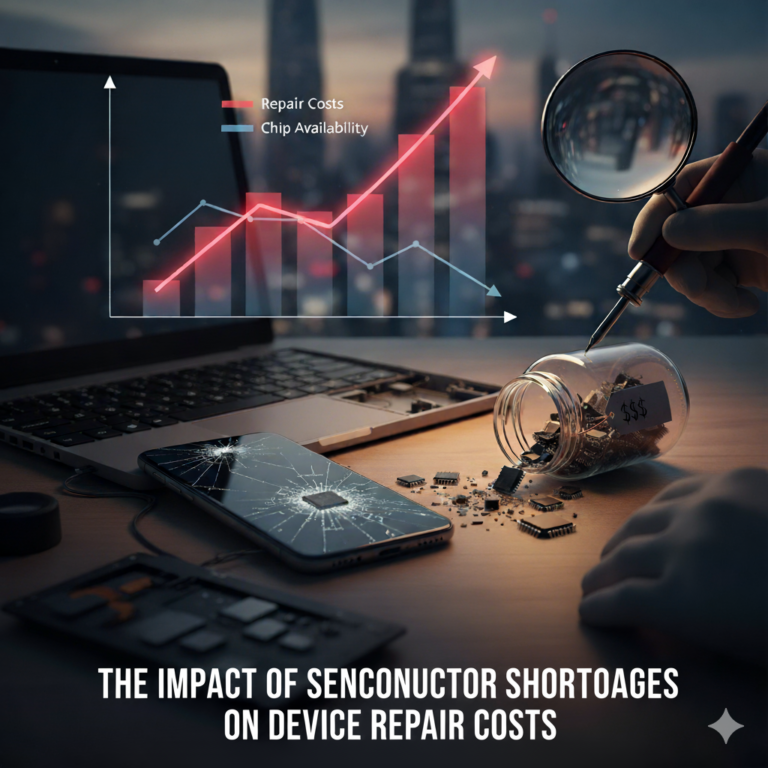
In the world of technology, semiconductors are the heart of every electronic device — from smartphones and laptops to home appliances and even cars. Without these tiny chips, our modern digital lifestyle would come to a halt. But what happens when there’s a shortage of semiconductors? For repair shops and consumers alike, the effects are significant.
Over the past few years, Australia — like the rest of the world — has experienced waves of semiconductor shortages that have driven up the cost of device repairs. Let’s explore how this ongoing chip crisis impacts repair costs, why it matters to consumers, and what repair experts like SmartElectronix are doing to help customers navigate these challenges.
⚙️ Understanding the Semiconductor Shortage
A semiconductor (commonly known as a chip or microchip) controls everything from charging your phone battery to connecting your laptop to Wi-Fi. When supply chains were disrupted during the pandemic, chip production slowed dramatically.
At the same time, global demand for electronics skyrocketed — people were buying more laptops, gaming consoles, and smartphones than ever before. Manufacturers couldn’t keep up, and a ripple effect began that is still felt today.
Even as factories resumed production, geopolitical tensions, transportation delays, and raw material shortages created new bottlenecks. The result? A smaller supply of chips and higher costs for everyone — including device repair services.

💸 Why Semiconductor Shortages Increase Repair Costs
The connection between chip shortages and repair costs is direct but multi-layered. Here’s how it affects everyday Australians when they visit a repair shop:
1. Higher Parts Prices
Many replacement parts used in phone repair, laptop repair, or motherboard repair depend on semiconductor availability. When chips are scarce, the cost of these parts increases.
A simple IC (integrated circuit) that previously cost $5 might now be priced at $20 or more. For consumers, that can mean higher quotes for motherboard replacements, screen repairs, and even battery replacements.
2. Limited Availability of Genuine Parts
When original chips or boards aren’t available, repair shops often face long delays or have to look for refurbished alternatives. While refurbished devices and components can still perform well, sourcing them takes time — increasing turnaround periods for customers waiting to get their gadgets back.
3. Increased Labor Time
Repair technicians spend more time diagnosing and testing alternative parts when semiconductors are in short supply. Extra testing and compatibility checks mean higher labour costs, which can add to the final repair bill.
🧠 How the Shortage Impacts Different Devices
Smartphones
Modern smartphones use hundreds of tiny chips that manage everything from camera sensors to power regulation. When specific chips are out of stock, repairs such as motherboard reworks, camera replacements, or charging port fixes can become more expensive or delayed.
Laptops and PCs
Laptop repair services face challenges with GPU, CPU, and logic board components. Many chips used in older laptop models are no longer in production, forcing repair shops to rely on aftermarket or salvaged components — both of which come at a premium.
Gaming Consoles and Other Electronics
Gaming consoles and smart home devices are also affected. Shortages make it harder to find compatible chips for mainboards or controllers, raising both repair costs and replacement timelines.
Fixing Devices. Building Trust.

🔧 How Smart Repair Shops Are Adapting
Forward-thinking repair services, such as SmartElectronix, are finding creative ways to overcome the chip crisis and keep repair prices affordable for customers.
1. Recycling & Harvesting Components
Instead of relying solely on new parts, technicians can harvest working chips and modules from non-functional devices. This process helps reduce waste and ensures a steady supply of spare components for critical repairs.
2. Refurbished and Sustainable Repairs
Refurbished devices and recycled parts aren’t just cost-effective — they’re environmentally friendly. Offering customers the option to use refurbished components helps maintain affordability without compromising performance.
3. Preventive Maintenance Plans
To reduce emergency repair costs, many Australian repair shops are now promoting maintenance plans. Regular check-ups help detect early issues like battery degradation or overheating chips before they turn into expensive motherboard failures.
4. Investing in Advanced Diagnostics
Modern AI-powered and AR-assisted diagnostic tools help technicians quickly locate the root cause of a fault. By diagnosing precisely, fewer unnecessary parts are ordered — saving both time and money.
🌏 The Australian Perspective
In Australia, the repair market is highly reliant on imported parts. When semiconductor production slows in Asia or the U.S., it directly affects local supply chains. Shipping delays and currency fluctuations also contribute to fluctuating repair costs.
However, the Australian government and local businesses are increasingly advocating for the “Right to Repair” movement — an initiative promoting access to affordable parts and repair information. This movement helps independent repair shops like SmartElectronix continue serving customers without relying solely on manufacturer restrictions.
💡 Tips for Consumers During Semiconductor Shortages
If you’re planning a repair soon, here’s how you can save money and time during the chip shortage:
-
Act quickly: Don’t delay small issues like screen flickering or battery swelling. Early repairs are often cheaper.
-
Choose refurbished parts: Ask your technician if they offer high-quality refurbished replacements.
-
Get preventive servicing: Regular maintenance can extend your device’s life and prevent expensive chip-related failures.
-
Work with trusted repair shops: Choose experienced repair services that provide warranty, genuine or tested parts, and transparent pricing.
🔮 Looking Ahead: When Will Things Get Better?
Experts predict that global chip production will continue to stabilise through 2025–26 as new semiconductor fabs open in Asia and the United States. However, since many devices still rely on older chip architectures, certain components may remain limited.
For the repair industry, the focus will shift towards innovation and sustainability — reusing parts, improving diagnostics, and offering smarter service packages to keep costs manageable for customers.
✅ Final Thoughts
The semiconductor shortage has changed the dynamics of the entire repair ecosystem. From higher part costs to longer waiting times, it has forced both technicians and consumers to rethink how they manage their electronic devices.
At SmartElectronix, the mission remains clear — to deliver affordable, sustainable, and expert repair services no matter how the market shifts. Whether it’s a phone repair, laptop repair, or battery replacement, the team is committed to keeping your devices running smoothly — even in a world where microchips are worth more than gold.
